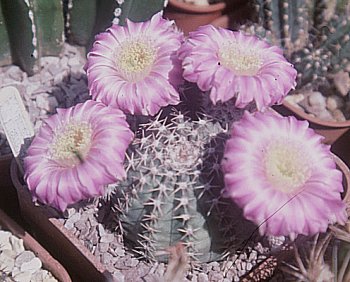Flower EncyclopediaENTER THE WORLD OF FLOWERS |
Other News
Echinocactus
Category: Cacti
18 Jul : 11:00
To view pictures click on them








 Roda was first described in 1827 by Heinrich Friederich Link and Friederich Christoph Otto. The name comes from the Latin word "echinatus" - prickly and comes from a time when most cacti are rounded to the family concerned Ehinokaktus and those with cylindrical shape of the stems - or the genus Tsereus Ehinosereus.
Roda was first described in 1827 by Heinrich Friederich Link and Friederich Christoph Otto. The name comes from the Latin word "echinatus" - prickly and comes from a time when most cacti are rounded to the family concerned Ehinokaktus and those with cylindrical shape of the stems - or the genus Tsereus Ehinosereus.Genus includes ten species, among the largest of the famous round and cylindrical cactus. Close relatives are Ferokaktusite. The stems are bright green, smooth and shining, in nature reach a height of 3 meters and 1.5 meters in diameter. Ribs are numerous, straight, heavily armed. Large halo on top almost merge with each other and form a tight, billowy coating. Spikes are not numerous, their color is amber-yellow, are thick, 2.7 cm in length, in the majority of species are very strong and solid, with styliform form. In nature, plants bloom only old, at home generally do not Ehinokaktusite zatsaftyavat. The colors are yellow or dark pink, the shape of a crown is not large, 2.5 cm in diameter, are narrow, spear petals, have in a circle around the tip of the stem. In naturally pollinated by insects or small birds. Color tube is short, resnichesta covered with scales. Fruits are dry, to shatter.
Popular species are: F. viereckii, E. amoenus, E. enneacanthus, F. acifer, F. engelmanii.
Cacti of this genus are distributed in southwest U.S. and northern Mexico. Grown on clay-chalky soil, mainly in desert areas in the foothills and slopes of rocks in mountain gorges, where almost no other vegetation. In the past it was quite possible to encounter large groups of Ehinokaktusi age from 200 to 400 years, today it is difficult to detect even single copies of such age. Only in El Paso (Texas) in place works were destroyed more than 500 of these valuable plants.
Ehinokaktusite in rearing, the only problem that you may encounter is providing a place for older plants. In intense sunlight, constant flow of fresh air and moderate watering during the growth Ehinokaktusite grow relatively quickly, but is waiting to blossom is not an easy task. Most species grow well in a substrate composed of equal parts of 40% and chimovka leaflet, 30% mixture of gravel and rubble, 10% limestone additions, other aggregates. So-called "small" Ehinokaktusi (E. horizonthalonius, E. parryi, E. xeranthemoides), to be added to the substrate to 20% by volume gravel components and reducing the amount of irrigations. In winter, older plants are kept dry at 6.10 degrees. More sensitive species prefer winter temperatures 8.10 degrees.
Ehinokaktusite reproduce by seed. Semenachetata growth may accelerate, making grafts, and then again podrasnalite rooted specimens. Graft from the remaining "stalks" may serve as vegetative propagation, as readily form shoots.
Ehinokaktusite are extremely popular and widespread in collections.
SPECIES
* Echinocactus grusonii
Minimum temperature: for short periods of time, withstand temperatures up to -10 掳 C, average winter temperature of 12 掳 C.
Position: full sun
Origin: Mexico (San Luis Potosi, Hidalgo). The local name of the cactus is a "golden ball".
Description: The stems are light green, round, with age slightly reimbursed never formed lateral shoots. 200-300 year old specimens of more than 1 meters height and 70 cm in diameter. Are about 30 ribs, sharp, high, straight, separated at an early age of alternating depressions and protrusions. Areola towards the top to have more tightly and form a dense coating. Radial spines are 8.10 in cash, up to 3 cm central spines are arranged crosswise and 5.7 cm long bodlichki All are characterized by special decorative, transparent color is yellow, and are extremely tough and hard, slightly 懈蟹胁懈褌懈 泻褗屑 芯褋薪芯胁邪褌邪 薪邪 褋褌褗斜谢芯褌芯. Zatsaftyava aged 30-40 years, the period of flowering is from March to late April. The colors are yellow, long and about 5 cm in diameter, appear only in old plants. Fruits are up to 2 cm long, covered with white, wavy hairs.
Subspecies:
- Echinocactus grusonii fa. subinermis - stem is round in shape, reaching a height of 1,20 m. and 1 m. in diameter, the epidermis is light green. The top is wavy. In comparison with other species of the genus, almost no thorns, they rarely reach 4-5 mm. in length and are yellow in color. Flowers are small, insignificant, yellow inside and brown on outside.
* Echinocactus horizonthalonius
Minimum temperature: for short periods of time, withstand temperatures up to -10 掳 C, average winter temperature of 12 掳 C.
Position: full sun
Origin: from the southwest U.S. (Arizona, New Mexico), to northern Mexico (Nuevo Leon, San Luis Potosi). This type Ehinokaktus come from regions in which only receives 20-30 cm of water per year, strong sunshine and heat. So it needs very little water and a lot of sun. That grows on soil rich in limestone, so it is better to add than that in the mineral substrate for cultivation.
Description: Echinocactus horizonthalonius is the smallest of Ehinokaktusite and the only one who will zatsafti in growing in pots. The stems are gray-blue, round to slightly elongated, reaching to a height of 30 cm in diameter, about 20cm. Without side shoots. Ribs about 10 in number (usually 8) are rounded, spirally arranged. Areola are round, a distance of 1.2 cm between each other. Central spines from 3 to 5 numbers (with a thickness of 2.5 millimeters.), And radial are 6-9 per number in young plants are dark red, amber with age are at the base are dark, hard and curved, length 2.4 cm colors grow on top and pink or red with a length and a diameter of 5.6 cm to 6 cm of flowering lasts from March until late May. Fruits are red, elongated, semi-arid, heavily Ciliate with a length of 3 cm in nature mature in May-June. The seeds are large, brownish black.
Subspecies:
- Echinocactus horizonthalonius var. nicholii - comes from the southern parts of Arizona and Sonora (Sierra del Viejo), and endangered species. Usually there are 8 ribs, the central spines are 3 in number, and radial 8.
* Echinocactus parryi
Origin: Mexico - Chihuahua, Lake Guzman, endemic species threatened with extinction.
Description: Grows as a single plant, the stems are round, high of 16 to 25 cm and a diameter of 21 to 30 cm concave top is covered with white hairs. Ribs 13 to 21, slightly rounded. Areola diameter is 12 mm. In part from a bodlichkite out, reaching 1.5 millimeters. In part out of that color and covered with moss. Spikes are hard, strong, sometimes flattened, whitish in color. Radial spines are 8 of 11 in number, straight or slightly curved, these are thinner. There are 4 central spines, large in length from 4 to 10 cm, slightly rounded at the base, rising straight or slightly curved. The colors are golden yellow. Color tube is densely covered with hairs. The fruit is oblong.
Cultivation: Cactus grows very slowly and is quite difficult for cultivation.
* Echinocactus polycephalus
Low: withstand temperatures up to -12 掳 C, average winter temperature of 12 掳 C.
Position: full sun
Origin: USA (Mohave Desert and Sonoran: Arizona, California, Nevada), Mexico (northwestern Sonora), a small altitude. Grows in very dry places, on rocky and sandy soils.
Description: It grows in groups, some colonies may consist of more than 100 cactus. The stem is spherical or slightly cylindrical, 30-60 cm high with a diameter of 9-20 cm 12-18 Ribs, deep from 0,8 to 1,2 mm. Areola is large, whitish gray in color, with a length of 1 cm wide and 1 to 3,5 cm central spines are 4 in number, 5.9 cm long and 6.8 are the radial length of the number 2, 5.5 cm spikes of color is brown with red ivichki. The colors are yellow, 5.6 cm long, flowering period is February-March. Fruit is round, dry, covered with cloth, opens from the base when ripe. The seeds are big and black in color.
Subspecies:
- Echinocactus polycephalus ssp. xeranthemoides
* Echinocactus platyacanthus (synonym Echinocactus ingens)
Low: withstand temperatures up to -4 掳 C, average winter temperature of 12 掳 C.
Position: full sun
Origin: Central Mexico
Description It grows singly, in the form of a home field with it kolonoviden age, reaches a length of 2 m and a width up to 1m. Epidermis is light green. Top is covered with strong cloth, it blossom buds. Radial spines are 4 to 8 and the central 1 to 4 in number, as long. The colors are yellow.
Subspecies:
- Echinocactus platyacanthus fa. grandis
Origin: Central Mexico
Description: Single, large cactus with cylindrical bole, high to 1-2 meters and a diameter of 60-100 cm, its color is dark green when young cacti are noted wide horizontal stripes. Tip is very undulating. Ribs in young plants are 8, wide, high and more or less wavy, but older plants are numerous and rather thin. Areola are spaced in young plants and almost merge with older flowering cacti. Spikes are strong, solid with visible ivichki of them are yellowish at first, but then become brownish red. Radial spines are a number of 5-6, with a length of 3.4 cm single central spine is straight, 4.5 cm long flowers are yellow with a length of 4.5 cm around the pistil flakes are oblong, at base have numerous hairs that cover perikarpela with thick, plush coat. Narrow, hard-tipped upper flakes are like bodlichki. Fruit, hidden under a mass of long, smooth and white hairs are about 4-5 cm long seeds are shiny black.
Use: it stems from is known as a sweet prepared "acitron" or jam "viznaga". Used in the construction of houses or other buildings as a decorative element in the gardens.
* Echinocactus texensis
Low: withstand temperatures up to -18 掳 C, average winter temperature of 12 掳 C.
Position: full sun
Origin: northeast Mexico (Coahuila, Nuevo Leon, Tamaulipas), the southern parts of the United States (Texas and southeast New Mexico, Oklahoma)
Description: The plant is bluish green in color, stem without side shoots, reaching a size of 20 cm in height and 30 cm in width. The ribs are rounded and curved, 13 to 27 in number. Each rib in the age of the cactus is from 2 to 6 halo-coated mahche. Radial spines emanating from the areola are 6-7, with size 1.4 cm, color is red at first, becoming yellow with age. Central spine is just one long, 6 cm wide and up to 8 mm. May be slightly more or less strongly curved. The colors are pink to scarlet red, reaching a width of 6 centimeters. Fruits are round. Premises in which the plant is grown, at any time should be well ventilated. In the summer watering once a week. In winter, watering is limited to a minimum. It starts again in spring after emergence of flower buds.
Can be nurtured by watering during the spring and summer, once a month.
Transplanting is 2 - 3 godini.Otglezhdat the sun garden, conservatory or home. During the summer most - better to be exported abroad, if viewed in a pot.
The plant requires rich soil, but it must be well drained, with admixtures of sand and broken clay.
At home during the winter months the temperature should not fall below 2 degrees, because it may be detrimental to rastenieto.Razmnozhavane: By seed or stem cuttings.
| christoph otto mountain gorges chalky soil intense sunlight nature plants |
Comments are turned off for this item0
| christoph otto mountain gorges chalky soil intense sunlight nature plants |























































